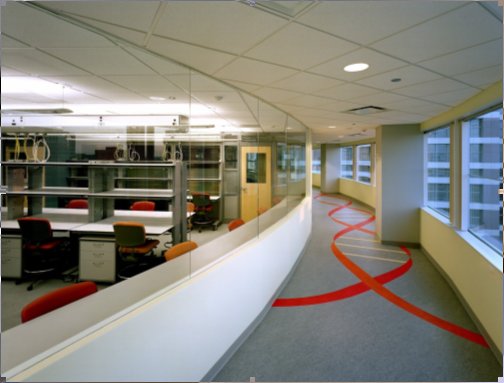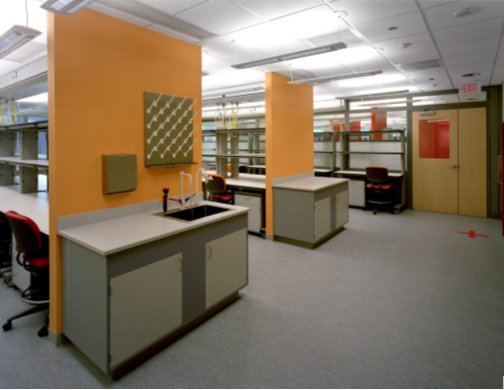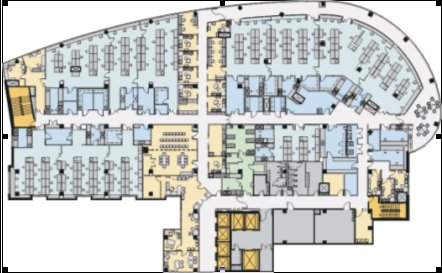CADVANCE News
October 2003 Oct. 2003 Issue
For all the latest Info
- www.cadvance.com
-
And much more…
This month news:
Hospital Designed by CADVANCE Contributed by Kevin Tenbrook
P&W Architects
This month featured article: Contributed by Mr. Alexander Medwedew
Visual Engineering
A tip of information: Contributed by Carol Johnson
Whitaker & Rawson, Inc
To AETools V2002 Site License users:
CADVANCE 2002 Service Pack 5 is now available.
=========================================================================
Hospital Designed by CADVANCE P&W Architects
Contributed by Kevin Tenbrook, Leslie Tyer



Note: For better pictures, please go Gallary
Working with Dr. Ferid Murad, Director of the Institute of Molecular
Medicine for the Prevention of Human Diseases and Nobel Prize recipient,
P&W designed the Institute's heart, cardiovascular and hypertension
research laboratory for The University of Texas Health Science Center at
Houston. The 34,200 gross square foot laboratory is located on the
ninth floor of St. Luke's Episcopal Health System's Denton A. Cooley
Building. This space is designed to accommodate a Director with 15
scientists and a technical support staff consisting of post-docs and
students. Expected population is 60 to 70 FTE's or one person per 200
ASF of laboratory space. Additional support areas include administrative and researcher offices, two large conference rooms and
support staff.
The design features fixed and mobile benches with lab gases, power, and
data supplied from overhead, surface- mounted utility raceways. This
approach to laboratory design allows maximum flexibility to support the
ever-changing programs. Office spaces were subdivided through the use
of demountable partitions to allow for rapid office reconfigurations
without the dirt, dust, and delays associated with normal drywall construction. Selecting and using sustainable materials, where
appropriate, was also part of the overall planning concept.
Construction Documents for the Institute of Molecular Medicine were
created in Cadvance by the Project Managers and senior staff working on
the project. P&W Architects has used Cadvance for many years because of
it's ease of use, and comprehensive capabilities. Because of its
extraordinary ease of use, even the principals of the firm continue to
use CAD on a daily basis - something that would be impossible using the
defacto architectural cad program.
by Alexander Medwedew
e-mail: CADVANCE@visual-engineering.com
In 1993, ISICAD introduced CADVANCE for Windows, which ran on the Microsoft Windows 3.X operating system. CADVANCE version 5.0 was the first Windows based CAD system to be introduced with a full set of ubiquitous features which included Multiple Document Interface (MDI), common application interface, clipboard and OLE compatibility. Also included was a newly designed macro programming interface called CADVANCE Developer Interface (CDI) and CADVANCE Basic Language (CBL) as its macro language. CDI provided a fully Microsoft Windows compatible interface for most professional programming environments like C that could write a Dynamic Link Library (DLL). Many of the features introduced in this ground breaking product were not fully matched by CADVANCE's main competition for many years.
Invoked from the CADVANCE utility menu, CBL provides customization and automation functions right out of the box. CBL, CADVANCE's default macro language, similar in syntax to Microsoft Visual Basic is also fully Windows compatible. Direct calls to the Windows API as well as custom DDL's and Active-X objects are well within the scope of its capabilities.
Over the years, CADVANCE users have discovered the benefits of using CBL for creating custom macros that make repetitive or difficult tasks easier to perform. The built-in macro recorder makes it easy to create reusable functions with a minimum of programming skills. Running a CBL macro is as easy as picking a shortcut key on the keyboard.
With all of its capabilities, CADVANCE's CBL macro editing environment only provides basic editing and debugging features. Large applications are difficult to write and CBL macro speed is limited due to being an interpreted language. Users of CADVANCE LiTe can only run macros created and compiled in the full version and cannot create CBL macros of their own.
To overcome the limitations of CBL, CDI allows alternative application development environments to be used. Many popular products that can create Windows compatible DLL's can be used to create custom applications for CADVANCE. The majority of these products use C as the programming language. C preferred by software development companies can be difficult to learn and code.
An alternative to C is a product made by Borland called Delphi. Delphi, a Rapid Application Development (RAD) environment uses Object Pascal as its language and is easy to use. Delphi provides a full set of professional features for CADVANCE application development and makes CDI features not available to CBL macros accessible. A number of applications have been written using Delphi, most notable and used by many CADVANCE users is AETools. FIT has plans to further utilize Delphi for its other add-on products currently written in C.
Features not directly available to CBL are easily accessible using Delphi. Custom forms are simple using Delphi's forms editor. Debugging applications using the Delphi debugger allows rapid detection of programming errors. The ability to create custom objects known as Auxiliary Objects is only possible by writing a custom DLL. Delphi allows deployment of functions in a single plug-in library for easy distribution and maintenance of applications.
The gain in speed of custom applications may be the greatest advantage for most custom applications. CBL macros that seem slow will benefit the most from conversion. The transition from CBL to Object Pascal requires learning a different programming language. The CADVANCE specific CDI function calls remain the same and useful macros written in CBL are fairly easy to convert.
CADVANCE requires Delphi applications to be written as DLL's. Usually located in the CADVANCE program directory, DLL functions can be invoked from the Utility/Applications menu. CBL macros and other Delphi DLL's running inside of CADVANCE can have access to these functions as well. The following would need to be added to the CADVANCE.ini file so that the application would be visible in the Applications menu.
[3rd Party (CADVANCE.ini)]
Multiline &Hello=AuxNew CadvUtils.dll 2D
Multiline &Hello=AuxEdit CadvUtils.dll 3DBorland Delphi is an important addition to any CADVANCE users set of tools for creating custom CADVANCE applications. CADVANCE is also a great platform for Delphi developers that are looking to create powerful CAD applications.
CBL (BASIC) version of DrawLine
Sub DrawLine()
Dim i_ret as Integer
Dim l_ret as Long
Dim i_term as integer
Dim i_menu as integer
Dim startPoint as CDI_DD_POINT
Dim endPoint as CDI_DD_POINTCdiDeleteCursor
i_ret:=CdiGetPoint('Line point #1', startPoint, i_term, i_menu)
i_ret:=CdiGetPoint('Line point #2', startPoint, i_term, i_menu)
i_ret:=CdiObjStartLine(startPoint,CdiGetActLayer(),CdiGetStyle(),CdiGetWeight(),CdiGetCurColor())
l_ret:=CdiObjAddtoLine(endPoint,CDI_DRAWTO)
l_ret:=CdiObjEnd(CDI_TRUE,CDI_TRUE,CDI_OBJECT_COLOR)
End subDelphi version of DrawLine
procedure DrawLine;
var
i_ret:integer;
l_ret:LongInt;
i_term:integer;
i_menu:integer;
startPoint:CDI_DD_POINT;
endPoint:CDI_DD_POINT;begin
CdiDeleteCursor;
i_ret:=CdiGetPoint('Line point #1', startPoint, i_term, i_menu);
i_ret:=CdiGetPoint('Line point #2', startPoint, i_term, i_menu);
i_ret:=CdiObjStartLine(startPoint,CdiGetActLayer,CdiGetStyle,CdiGetWeight,CdiGetCurColor);
l_ret:=CdiObjAddtoLine(endPoint, CDI_DRAWTO);
l_ret:=CdiObjEnd(CDI_TRUE, CDI_TRUE, CDI_OBJECT_COLOR);
end;Simple Delphi DLL
library CadvUtil;
uses
Windows,
SysUtils;//CADVANCE declarations go here
procedure CdiPutMsg(information_msg: pchar); stdcall;
external 'CAD1.DLL';procedure CdiPutInfoMsg(title: pchar; info_msg: pchar); stdcall;
external 'CAD1.DLL';//functions and procedures go here
procedure StartApp;stdcall;
begin
CdiPutInfoMsg('CADVANCE Utilities', 'Hello World');
end;procedure DllExitHandler(Reason:integer);
Begincase Reason of
DLL_PROCESS_DETACH : ;
DLL_PROCESS_ATTACH : ;
DLL_THREAD_ATTACH : ;
DLL_THREAD_DETACH : ;else
end;end;
//list the exports here
exports
StartApp;begin
{ Perform DLL initialization }
DLLProc:=@DLLExitHandler;
DLLExitHandler(DLL_PROCESS_ATTACH);CdiPutMsg('Initializing utility module, please wait...');
end.
---------------------------------------------------------------------------------------------------
- Editor's Note: Takashi Furukawa, President of F I T, Inc., said, "As part of future product development plans, CADVANCE will be enhanced and upgraded using C++ and the future CADVANCE add-on applications will be developed in Delphi and C++."
- =======================================================================
A tip of information form Carol Johnson, Whitaker & Rawson, Inc.
For the users who use plot files often:
The goplot seems to be an easy tool that some people we deal with can easily manage. There is also a plt to dxf tool.
To
AETools V2002 Site License users:
latest AETools Site version should have been delivered but was not).
If you are running AETools Site License V2002, please check the "Last
Modified Date" of the AETools Site License file and confirm that its
"Last Modified Date" is earlier than November 2003. Then,
download from here,
un-zip the AET2002SITE.ZIP file and install AETools Site.
The improvements are:
AESetup,
AEPlan Tab. The dialog has increased up to 48 setups.
Permits the user to change the labels on the "Group Options" screen.
So the three labels which currently say "Group 1", "Group
2", and "Both" are user-definable.
5 Available
CADVANCE 2002 SP
CADVANCE 2002 Service Pack 5
Update is available at no charge, to all CADVANCE Full Version 2002 Users!Please download and run SP5.
|
|||
|